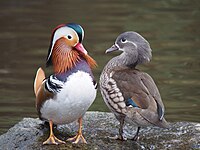
Photo from wikipedia
Male and female gametes differing in size—anisogamy—emerged independently from isogamous ancestors in various eukaryotic lineages, although genetic bases of this emergence are still unknown. Volvocine green algae are a model… Click to show full abstract
Male and female gametes differing in size—anisogamy—emerged independently from isogamous ancestors in various eukaryotic lineages, although genetic bases of this emergence are still unknown. Volvocine green algae are a model lineage for investigating the transition from isogamy to anisogamy. Here we focus on two closely related volvocine genera that bracket this transition—isogamous Yamagishiella and anisogamous Eudorina. We generated de novo nuclear genome assemblies of both sexes of Yamagishiella and Eudorina to identify the dimorphic sex-determining chromosomal region or mating-type locus (MT) from each. In contrast to the large (>1 Mb) and complex MT of oogamous Volvox, Yamagishiella and Eudorina MT are smaller (7–268 kb) and simpler with only two sex-limited genes—the minus/male-limited MID and the plus/female-limited FUS1. No prominently dimorphic gametologs were identified in either species. Thus, the first step to anisogamy in volvocine algae presumably occurred without an increase in MT size and complexity.Takashi Hamaji et al. report genome assemblies for two volvocine green algae species spanning the transition from isogamy to anisogamy. Unexpectedly, they found that both species’ mating type loci (MT) are simple, suggesting their transition to anisogamy occurred without increased MT size and complexity.
Journal Title: Communications Biology
Year Published: 2018
Link to full text (if available)
Share on Social Media: Sign Up to like & get
recommendations!